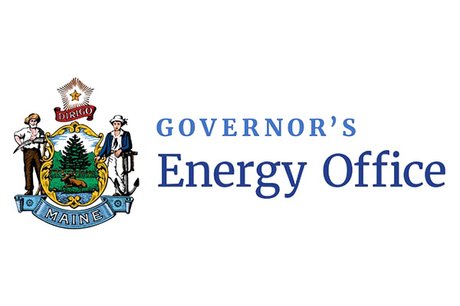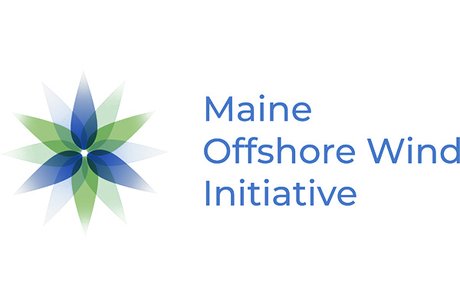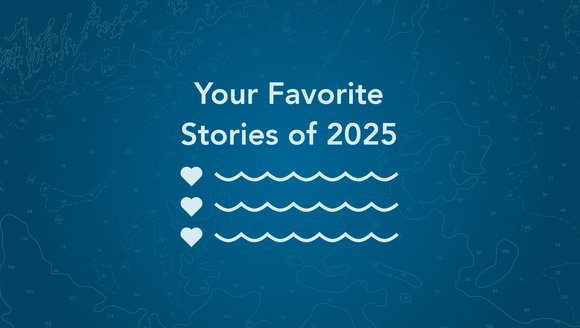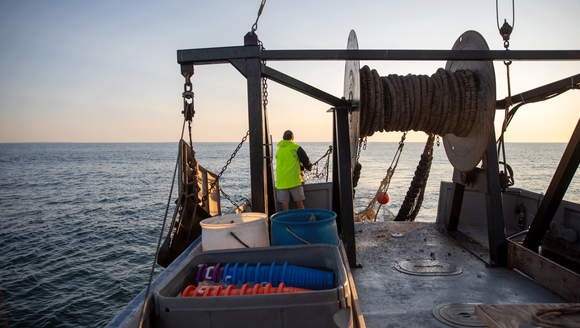Understanding Interactions: Gulf of Maine Fisheries and Offshore Wind
Understanding the intersection of fisheries and floating offshore wind.
This project helps improve our understanding of how fishing activities will interact with floating offshore wind, and explores approaches for these industries to coexist alongside each other. Through stakeholder engagement, data analysis, and global expertise, we explored sustainable coexistence strategies to ensure the vitality of local fisheries while embracing new clean energy solutions. We focused on using local fishing insights to provide recommendations that can shape the future of offshore wind development.
Project Goals:
- Engage with the Gulf of Maine’s fishing industry to identify local experiences that inform guidelines on whether and how fisheries and offshore wind industries can coexist.
- Enhance the understanding of the interactions between fishing methods and floating offshore wind infrastructures to minimize potential operational conflicts.
- Identify existing data gaps in floating offshore wind and fisheries interactions through targeted research, promoting informed decision-making for future projects.
The Gulf of Maine may be one of the first regions in the nation to deploy floating offshore wind. This advancement, however, poses challenges for the region's vital fisheries, which may be impacted by the turbines' complex anchoring systems and spatial demands. It's crucial to deepen our understanding of how fisheries will interact with floating offshore wind technologies to ensure responsible offshore wind development that accounts for multiple ocean uses.
To address this, with funding from the Maine Governor’s Energy Office, we collaborated with ERM Consulting & Engineering to explore approaches to fisheries’ coexistence with floating offshore wind. This project focused on identifying coexistence strategies that ensure environmental sustainability and preserve the economic fabric of the Gulf of Maine.
The fishing industry is crucial to our regional identity and economy, yet there is limited commercial-scale research on the coexistence between fishing and floating offshore wind and its relevance to the Gulf of Maine fishing industry (i.e., gear and species). Findings from this research support both industries in navigating the development process, and promoting mutual prosperity.


Our Approach
We leveraged the expertise of local fishermen, fishing associations, NGOs, and specialists in engineering and environmental assessment to inform our findings. The study fills critical data gaps by examining how existing floating offshore wind projects and fisheries interact, taking into account the gear and practices unique to the Gulf of Maine's fishing industry.
ERM led the review of sustainable floating offshore wind designs, regulations and completed a desktop compatibility assessment, while we at GMRI documented current fishing operations, considering various factors like gear, location, vessel size, effort, and species, and coordinated robust fisheries engagement. We aligned our findings with industry knowledge to ensure applicability within proposed wind energy areas.
We led three phases of stakeholder engagement to understand fishermen’s perspectives on coexistence with floating offshore wind technology, soliciting and integrating fishermen’s feedback on the desktop research, technical compatibility assessment, and preliminary and final recommendations. As part of our engagement approach, we held focus groups, had one-on-one conversations by phone, Zoom, and in-person, and solicited input through surveys to understand the concerns of those in the fishing industry and the challenges that operating in a floating offshore wind array may pose to their work. For each phase of engagement, our team analyzed stakeholder input and presented it in individual engagement reports: Phase 1, Phase 2, and Phase 3.

Phase 1: Engagement with fishing industry stakeholders to discuss initial understandings, curiosities, and concerns regarding operability in and around floating offshore wind arrays.
Here's what we learned from stakeholders, who expressed:
- Doubts regarding the feasibility of the fishing industry coexisting with floating offshore wind.
- Concerns about mobile and fixed fishing gear becoming entangled with floating offshore wind infrastructure.
- Concerns with navigating and maneuvering around floating turbines and associated infrastructure, which may lead to increased operational hazards for vessels and crews.
- Uncertainty about how floating offshore wind development may affect livelihood and community dynamics.
- Uncertainty about the ecological impacts of floating offshore wind installations.
- Varying perspectives on the idea of coexistence:
- Some view coexistence as a shared space model where both the fishing and floating offshore wind industries adapt to operate with minimal disruption.
- Others believe coexistence is not possible due to inherent conflicts in the operational needs of the two industries.
Phase 2: Engagement with stakeholders to present different floating offshore wind technology scenarios – platform, mooring, anchoring, and cabling designs – and to receive feedback on how various gear types used in the Gulf of Maine may operate within floating offshore wind designs.
What we learned:
- Stakeholders shared concerns around mariner safety, technical and operational uncertainties, gear entanglement, and the potential environmental impacts of floating offshore wind technology.

- When presented with visuals of mooring (catenary, semi-taut, taut, and tension leg platform (TLP)) and platform types (spar, barge, semi-submersible, and TLP), stakeholders generally had preference for technologies with limited spatial footprints, both above and below the sea surface.
- Stakeholder suggestions for potential coexistence strategies include:
- Maintaining adequate spacing between turbines for fishing and navigating;
- Plotting floating offshore wind infrastructure on automatic identification systems;
- Employing markers or visual aids for floating offshore wind mooring and anchor locations to support navigation;
- Providing clarity on regulations and insurance policies that would allow fishing within floating offshore wind arrays.
- Conducting comprehensive research into the social, economic, and environmental implications of floating offshore wind development to understand potential impacts to stakeholders and the Gulf of Maine environment.
Phase 3: Engagement to present draft recommendations and a preliminary technical compatibility assessment to fishing industry stakeholders and Advisory Board members to consider their feedback, reactions, and opportunities for further research.
What we learned:
Stakeholders outlined a number of recommendations for promoting fisheries’ coexistence. A selection of these includes:
- Incorporating language into regulations to give the fishing industry greater influence in the decision-making process regarding floating offshore wind development.
- Conducting a comprehensive assessment of current fishing patterns in the lease areas with robust consultation with the fishing industry to optimize floating offshore wind array layouts by micro-siting turbine locations.
- Creating work and training opportunities for the fishing industry to support offshore wind surveys and operations as long-term positions to supplement existing, unaltered fishing operations.
- In consultation with local fishermen, considering turbine layouts that enable fishermen to fish in certain areas of a floating offshore wind array (e.g., incorporating fishing lanes).
- Ensuring that data are available to the public in accessible, understandable, interpretable formats (e.g., biological, oceanographic, geological, etc.).
- Accurately marking floating offshore wind anchoring lines, mooring structures, and cables to align with the existing charting practices used by the commercial fishing industry.
- Conducting site-specific compatibility assessments that incorporate feedback from fishermen on gear interaction risks.
- Conducting real-time monitoring of offshore wind impacts on fishing grounds to allow developers to adjust operations as needed.
- Funding fishing and navigational technology upgrades to avoid financial burdens on the fishing industry.
The recommendations above represent important perspectives from the fishing industry. Building on this input and findings from the desktop and technical compatibility assessments, ERM also developed recommendations aiming to promote coexistence between fishing and floating offshore wind activities. These include Engineering Recommendations, Case Study Recommendations, and Other Recommendations.

Next Steps
Throughout the Project, we also identified knowledge gaps and additional research topics as priorities for future work. As technologies in both floating offshore wind and fishing gear continue to evolve, additional research, innovation, and collaboration are needed to promote coexistence.
Our findings were shared as strategic recommendations to the Maine Governor’s Energy Office. These guidelines account for the dynamic offshore environment and the evolving nature of floating offshore wind, aiming to foster ongoing dialogue and collaboration among all parties involved. Ultimately, the goal is to balance the interests of the fishing industry, renewable energy industry, and the broader community, securing a sustainable future for all. For more details on this work, view the full report on the Maine Governor’s Energy Office website.
Beginning in the summer of 2025 and funded by Massachusetts Clean Energy Center, GMRI will be working with the United States Maritime Resource Center (USMRC) to continue enhancing the understanding of the interactions between fishing and floating offshore wind through virtual experiential learning and navigation simulation. With the expertise of our partners at USMRC, we will host immersive simulation experiences that allow fishermen to navigate and conduct fishing operations within simulated floating offshore wind arrays. The project will focus on developing experiential learning and visual assets that demonstrate the size, scale, and types of technology being developed for floating offshore wind. These scaled representations of floating offshore wind structures will help stakeholders understand floating offshore wind technology, equipping them with the information necessary to engage constructively in the offshore wind development process.
Project Team
-
Your Favorite Stories from 2025
Take a look back at some of our most-read stories in 2025.
Perspectives
-
The Next Wave of Maine’s Blue Economy
Reflections from the 2025 Blue Economy Investment Summit, and the future of Maine's blue economy.
Perspectives
-
Demystifying the Blue Economy
The blue economy is a hot topic these days, but the meaning behind the term isn't always clear. In this blog, we break down what …
Perspectives
-
Fisheries 101
Fisheries are the backbone of our state's economy and cultural heritage, but these systems are complex, and managing them even more so. Read on for …
Perspectives






